Airtable vs Google Sheets vs Rows: Which One is Better in 2025?

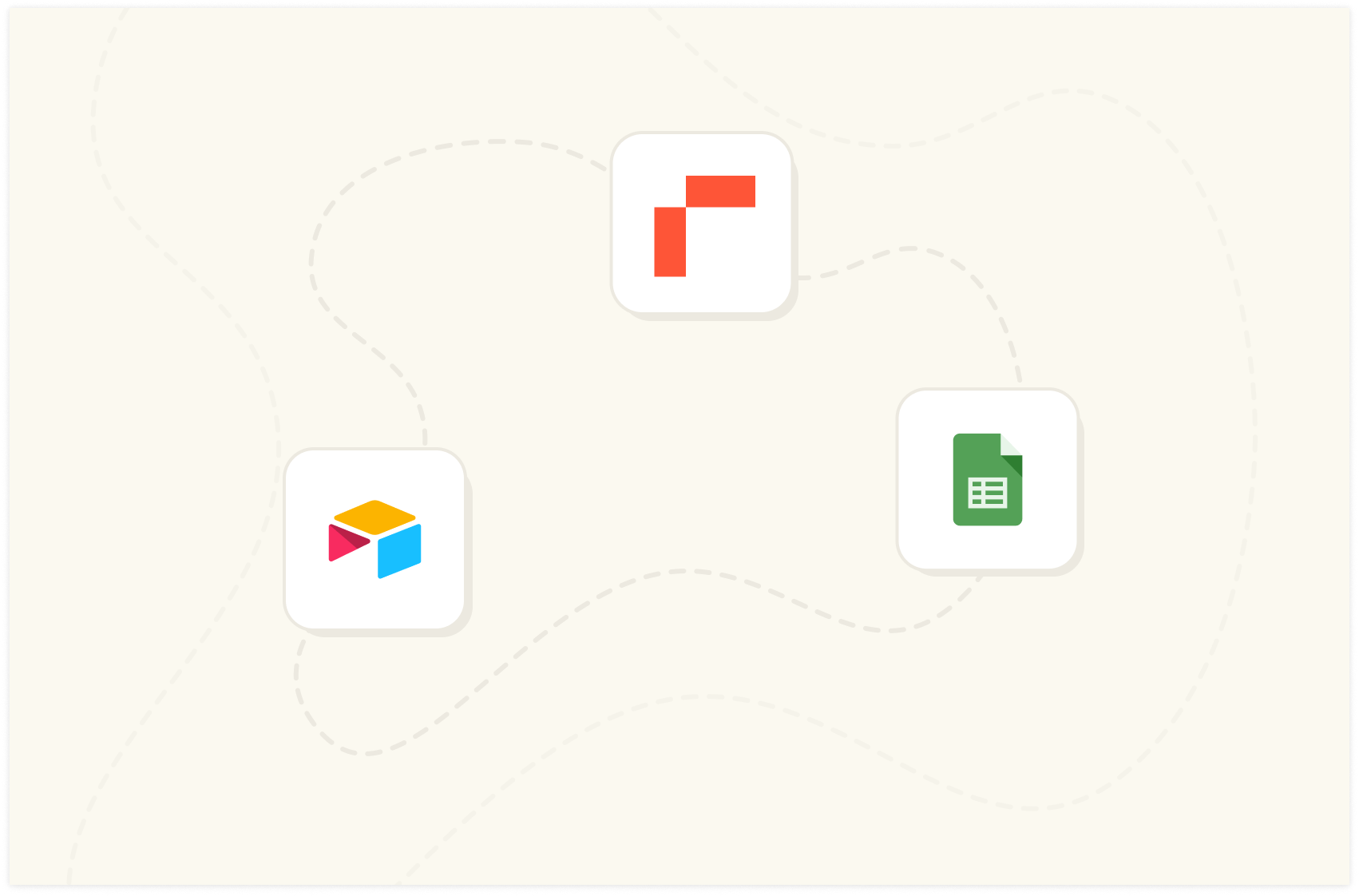
Airtable, Google Sheets, and Rows are all solid platforms that let you ingest data from multiple sources, manipulate and export data, and help you visualize better.
But how do you choose the best one for your needs?
Your ideal choice must be based on affordability, integration, and innovation.
To help you make an informed decision, I compared Airtable and Google Sheets with our tool – Rows.
Here’s what I found:
Airtable is a great tool if your priority is to build databases designed to support customizable apps and automations for your data process.
Google Sheets is great if you want to analyze and manipulate mid and large-size datasets and for seamless collaboration with your team and spreadsheet.
Rows is best if you want to analyze, manipulate and visualize data coming from multiple sources in a sleek, modern way. Rows comes with 50+ data integrations, AI capabilities, and beautiful sharing options.
To arrive at this conclusion, I conducted an in-depth comparison of the tools, including their features, integrations, pricing, and customer reviews.

Your new AI Data Analyst
Extract from PDFs, import your business data, and analyze it using plain language.
Try Rows (no signup)Features: Airtable vs Google Sheets vs Rows
Rows Features
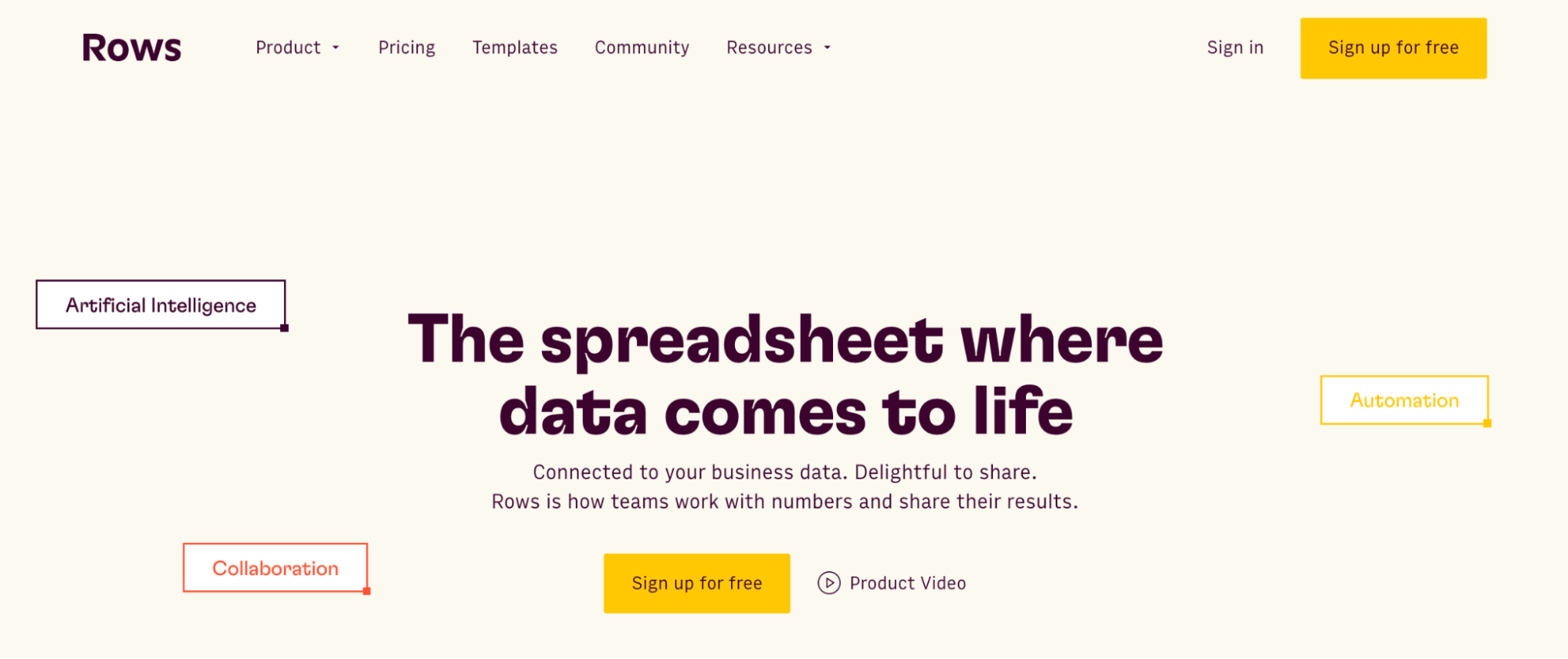
Data is an important part of tracking any business’s growth. It supports your decisions and tells you the reason behind a process's success or failure.
To track this data the right way, you need a spreadsheet software like Rows.
Rows makes it easy for you to transform and visualize data.
Here are the key features that make the software one of the best in the spreadsheet segment.
Feature 1. Data Integration
Rows integrates with more than 50 data sources and imports data from them in just a few clicks.
All data connectors in Rows are built-in native features, meaning that you don’t have to rely on external add-ons to use AI in your analysis.
Curious about how Rows pulls this off?
It handles JSONs in the grid and converts them into table format.
The feature comes in handy and saves you time.
Some examples of data integration in Rows are:
Import Google Analytics 4 data to Rows and get key analytics and reporting. Pick one of the recommended reports or build your own custom view as follows:
Or you can:
Connect your LinkedIn page and track comments to your posts.
Connect Slack to Rows and set alert automation to your #social channel whenever a new comment appears on your social media posts. All from a spreadsheet.
Import a Notion database in Rows with a few clicks, enrich data, and send it back to Notion.
The HTTP source sends GET, POST, PUT, and PATCH requests to any endpoint using basic or API token authentication methods. This helps you retrieve data from tools that aren’t in the Rows catalog.
💡Try it yourself in real time with the following HTTP tester:
Feature 2. Comes with Built-in AI to Answer Your Data-Related Questions
Rows makes it easy for non-data-friendly users to analyze and make decisions based on numbers. How? It’s all because of the platform’s inbuilt AI capabilities.
When it comes to AI, Rows has three main components:
1. AI Functions
Rows integrates with OpenAI for its 14 proprietary functions that automate prompts and address specific tasks:
Here’s one of the use cases of AI functions – EXTRACT_OPENAI in action:
Similarly, you can also execute sentiment analysis on a social media comment or product review using the function – SENTIMENT_ANALYSIS_OPENAI or clean up data using APPLY_TASK_OPENAI.
Discover more about all possible use cases of AI in Rows.
2. AI Analyst
With the AI Analyst, you can ask AI to analyze, summarize, transform, and enrich your analysis. Click on the "AI Analyst“ ✨ icon, at the top right corner of any table.
A chat interface will open on the right: you can ask a broad range of questions, from basic spreadsheet commands - plotting a chart or adding or formatting columns - to more complex tasks, such as slicing, pivoting, or computing metrics about your data.
For example, given a dataset with daily revenue and costs of various marketing campaigns, you can ask the Analyst to add a column with the profit margin. Watch the video below:
In addition, our AI Analyst is instructed to use our native OpenAI functions to perform data enrichment or extraction tasks.
For example, you can ask the AI analyst to run a sentiment analysis on a column with product reviews, or add a column that categorizes addresses into regions, see below:
Want to know more about how our Analyst works? Check out our guide or watch our demo.
3. AI Subtitles
Ask AI to generate subtitles for your tables and graphs that include key insights from the data displayed.
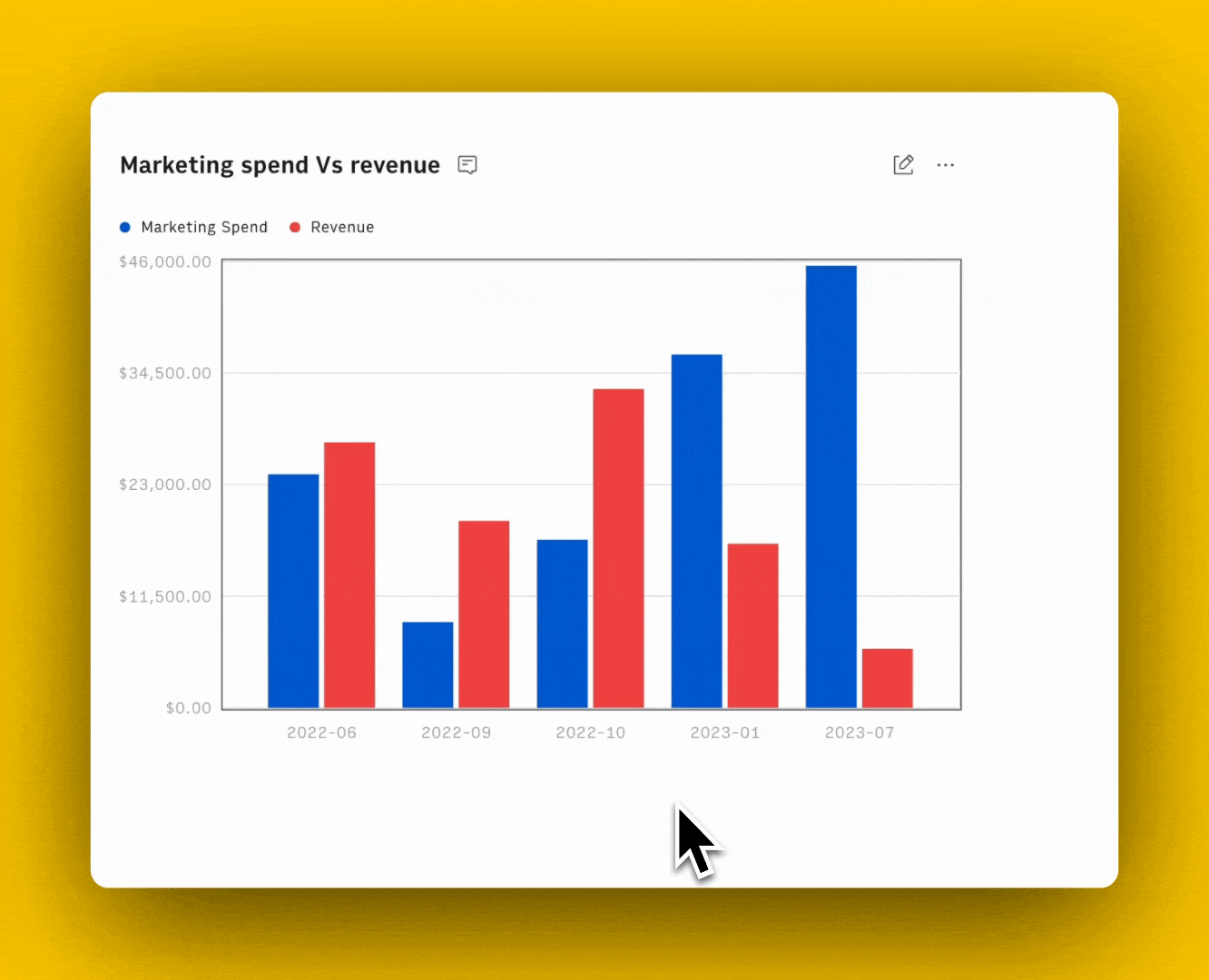
Feature 3. Build Layouts That are Delightful to Share
With Rows, you get the ability to build elegant dashboards that are shareable with your team and clients.
Here’s an example of our investor dashboard (numbers are dummy).

Apart from this, you can also embed tables and charts beautifully on Notion, Confluence, website, wiki, or other internal tools that support iframes with ease.
It’s a simple 4 step process:
Choose Embed in the settings menu located in the right-hand corner of the element you want to embed.
Click the Share Privately toggle.
Click <> Copy code. You can use the Copy link to paste directly into tools that automatically embed via the link - e.g., Notion.
Paste the embed code on your website, wiki, or destination tool.
See for yourself in the following interactive demo:
Learn how to use Embed in the most recent documentation tools, like Notion, Confluence, and Slite.

Your new AI Data Analyst
Extract from PDFs, import your business data, and analyze it using plain language.
Try Rows (no signup)Airtable Features

Unlike Rows and Google Sheets, which are spreadsheet apps, Airtable is a database app offering a more vivid and colorful way of handling data.
While Airtable still lets you present data in a spreadsheet view, the app's versatility and features exceed traditional spreadsheet utility.
Let's look at Airtable's features.
Data Visualization
Airtable offers seven distinct views – List, Grid, Timeline, Gantt, Gallery, Calendar, and Form views, to organize and manage data across departments and roles.
Its gallery view helps add context to data by showcasing images, designs, and creativity more effectively and in a comprehensive, organized format.
Unlike Rows and Google Sheets, which offer instant data visualization, Airtable has a roundabout process. The software’s marketplace offers extensions for adding visuals to your records. You can choose between charts, graphs, and top-line metrics to suit your team's reporting use cases.
You can also add other visualization elements, such as a flow chart, and widgets, such as a time tracker, to your dashboard.
This isn't the case with spreadsheet apps like Rows and Google Sheets. Especially with Rows, you don't rely on extensions for data visualization. Everything is in-built and native.
Interface Customization
Airtable lets you fully design your app interface with a convenient Interface Designer. Simply drag and drop components, choose colors, give role-based access to team members, and you're done.
Google Sheets users can use Apps Script to build custom menus and user interfaces. Still, comparably, Airtable's drag-and-drop builder is more capable of making a spreadsheet incredibly dynamic.
AI and Automation
Airtable AI lets you organize, analyze, and generate insights from data. It can help you:
Summarize insights
Analyze customer sentiments
Generate content drafts
Create automation
And more.
Airtable's visual automation builder is great, too. It lets you connect data to apps, triggers, and databases for synergy.

However, the borderline difference between Airtable AI and Rows AI Analyst is that the latter focuses on spreadsheet automation. Airtable AI cannot interact much with your data.
On the contrary, Rows AI Analyst can be used for cell-level data or primary spreadsheet functions. It can help you with formulas, generate content, analyze customer sentiments, identify trends and patterns, and more without leaving your spreadsheet.
Google Sheets Features

Google Sheets is a modern-day spreadsheet app. It provides pure spreadsheet utility, while introducing some automation and complete collaboration into data analysis.
That said, let's dive into its core features.
Data Manipulation and Analysis
Google Sheets is the more capable data manipulator when it comes to raw alphanumeric data. Its simplicity makes it more elegant when used across rows, columns, or sheets of data.
Google Sheets has the most extensive catalog of formulas and functions compared to the other two. It also lets you create custom functions with built-in Sheets formulas that are reusable across sheets.

Likewise, Rows allows you to do cell-level data transformations.
However, Airtable can't come close to matching this kind of functionality. While Airtable users can apply lots of formulas to a given dataset, they can't pinpoint specific records, rows, or columns as they can in Sheets.
AI and Automation
When it comes to AI and automation, Google Sheets isn’t as good as Rows and Airtable. Users rely primarily on third-party apps and custom scripts for automation.
Having said that, Gemini is slowly rolling out to Google Workspace (including Google Sheets), so there's still hope for Sheets users.
For now, users troubled by monotonous tasks can record macros to streamline their workflow. Macros are bite-size recordings of specific tasks. Once recorded, Sheets automatically performs those processes for you with a click.
Unlike Airtable's sophisticated automation, this is a simple automation procedure, but it's incredibly useful. In addition, you can find life-saving automation tools in Sheets, like auto-fill, AI data cleaning, data validation, removing duplicates, and trimming white spaces.
Data Visualization
Rows and Sheets both offer in-app visualizations. That means you don't need to add a third-party extension (like in Airtable).
You can visualize data using bars, charts, graphs, tree maps, histograms, and more in Google Sheets. The platform offers an extensive gallery of data visualization elements.
Its intuitive chart editor lets you customize charts for colors, layouts, and several other customization options.

Real-Time Collaboration
Google Sheets excels at real-time collaboration. Sheets allow multiple teammates to edit the same spreadsheet simultaneously while communicating via comments and in-app chat.
However, when too many collaborators work simultaneously, Google Sheets slows down, which might lead to software crashes.
From a pricing point of view, Sheets and Rows both offer unlimited collaborators on the free plan, while Airtable allows just five editors. Even at paid levels, any user with editing permission becomes another billable collaborator.
Which Spreadsheet Tool Has Better Features?
All three tools are winners in different feature aspects:
The use of AI and visualization features of Rows is better than Airtable and Google Sheets.
Google Sheets has the most number of functions and formulas to analyze complex data.
Airtable has the best customization options out of the three if you want to build apps and automations.
Integrations: Airtable vs Google Sheets vs Rows
Rows Integration
Rows integrates with 50+ different software that help you with data import and export, marketing, finance, translations, messaging, and more processes.
Some of the best integrations Rows offers are:
Marketing: Google Analytics 4, Google Ads, Instagram, TikTok
Finance: Alpha Vantage, Stripe, VAT-Search
Databases: Notion, HTTP, Snowflake, BigQuery, MySQL
Connectors: Make, Looker Studio, Microsoft Power BI, Zapier
CRM: Google Sheets, HubSpot, Zoho, Airtable
If the tool you are using is not in Rows catalog, you can always execute custom API requests to any endpoint with proprietary HTTP functions.
Lastly, one of the most important integrations of Rows that helps make data analysis a whole lot easier is with OpenAI.
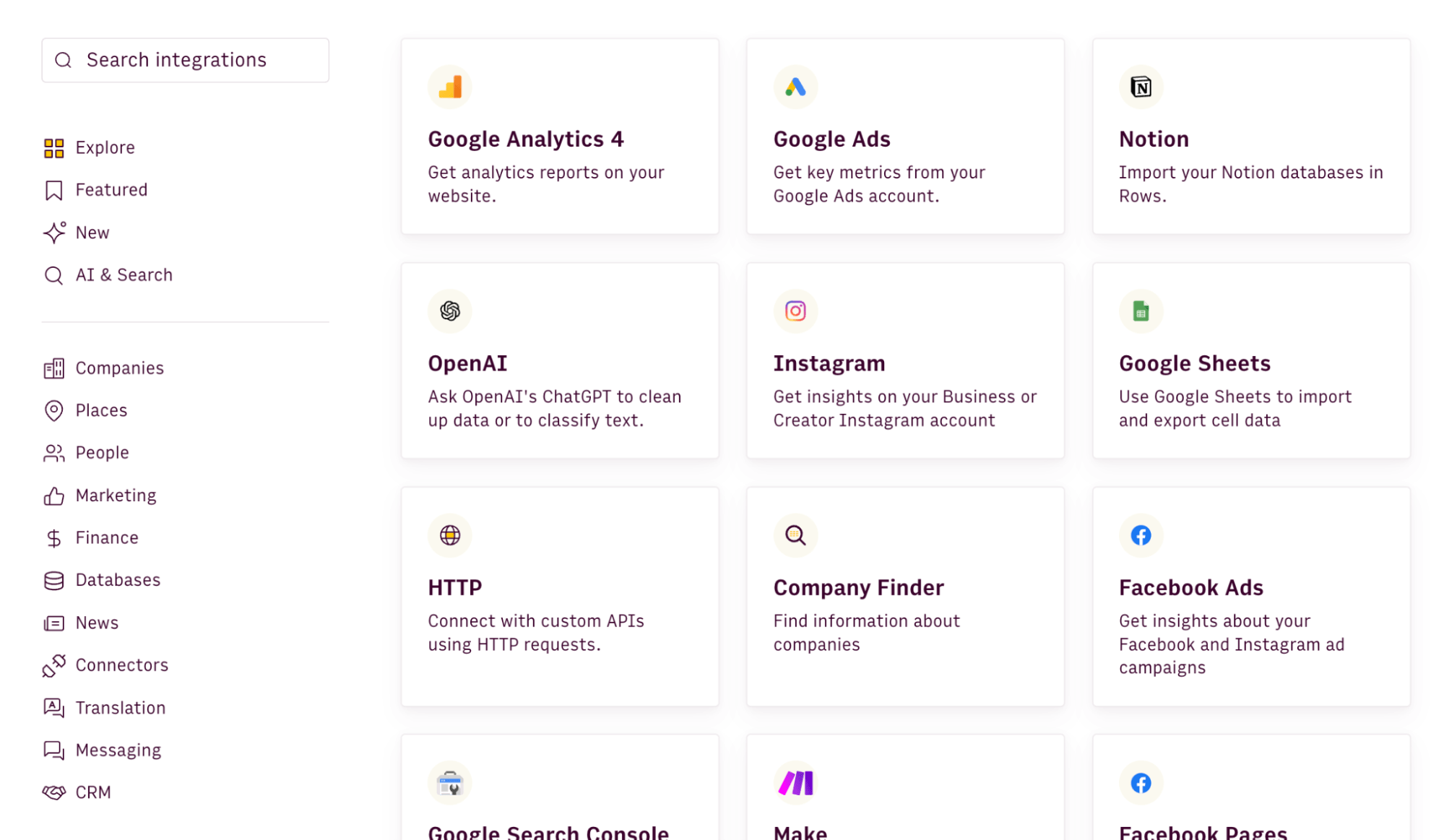
Airtable Integration
Airtable offers native integrations to apps in communication, social media, analytics, and project management categories. Some of the popular tools that integrate with Airtable are Slack, Instagram, YouTube, Salesforce, Asana, and 30+ others.

If we compare it with Rows, it integrates with 50+ apps without any third-party extensions. All integrations are native.
Compared to that, Airtable has a dedicated marketplace offering extensions (limited) to apps like Miro and Typeform. It also has additional open-source extensions that users can add via GitHub.
Google Sheets is no second to that. 👇
Google Sheets Integration
Google Sheets integrates with the Google Cloud Workspace apps by default. It also has native connectors to Looker Studio and BigQuery.

Like Airtable's marketplace, Google Workspace Marketplace offers hundreds of pre-built add-ons for sheets. You can expect add-ons to tools like Google Analytics, Lucidchart, Autocrat, Mail Merge, and Jira Cloud.
The key differentiator is that Google Workspace Marketplace has more offerings than Airtable.
You'd find a large library of apps, AI tools, and connectors capable of transforming Sheets into a dynamic data management tool.
To add extensibility, both Airtable and Google Sheets offer a Zapier integration, so you can connect them to thousands of other apps.
Which Spreadsheet Tool Has Better Integration?
Rows and Airtable both have a great set of integrations that help you with data import/export, marketing, finance, and more.
The only difference is Rows takes it a step forward because all its integrations are native, and all Airtable integrations are via a marketplace.
Pricing: Airtable vs Google Sheets vs Rows
Rows Pricing
Rows comes with a free forever plan that lets you:
Onboard unlimited team members
Add up to 10 guests
Create unlimited spreadsheets
Execute 50 integration tasks per month
The free plan is quite generous. But if you want to use data integrations at scale, want white-labeled embed, video support, and more, you have the option to upgrade to one of the paid plans Rows offers:
Plus: $15/month/member, up to 25 guests, unlimited integration tasks & daily data refresh.
Pro: $22/month/member, up to 100 guests, unlimited integration tasks & hourly data refresh.
Enterprise: Custom price for advanced API usage and workflows.
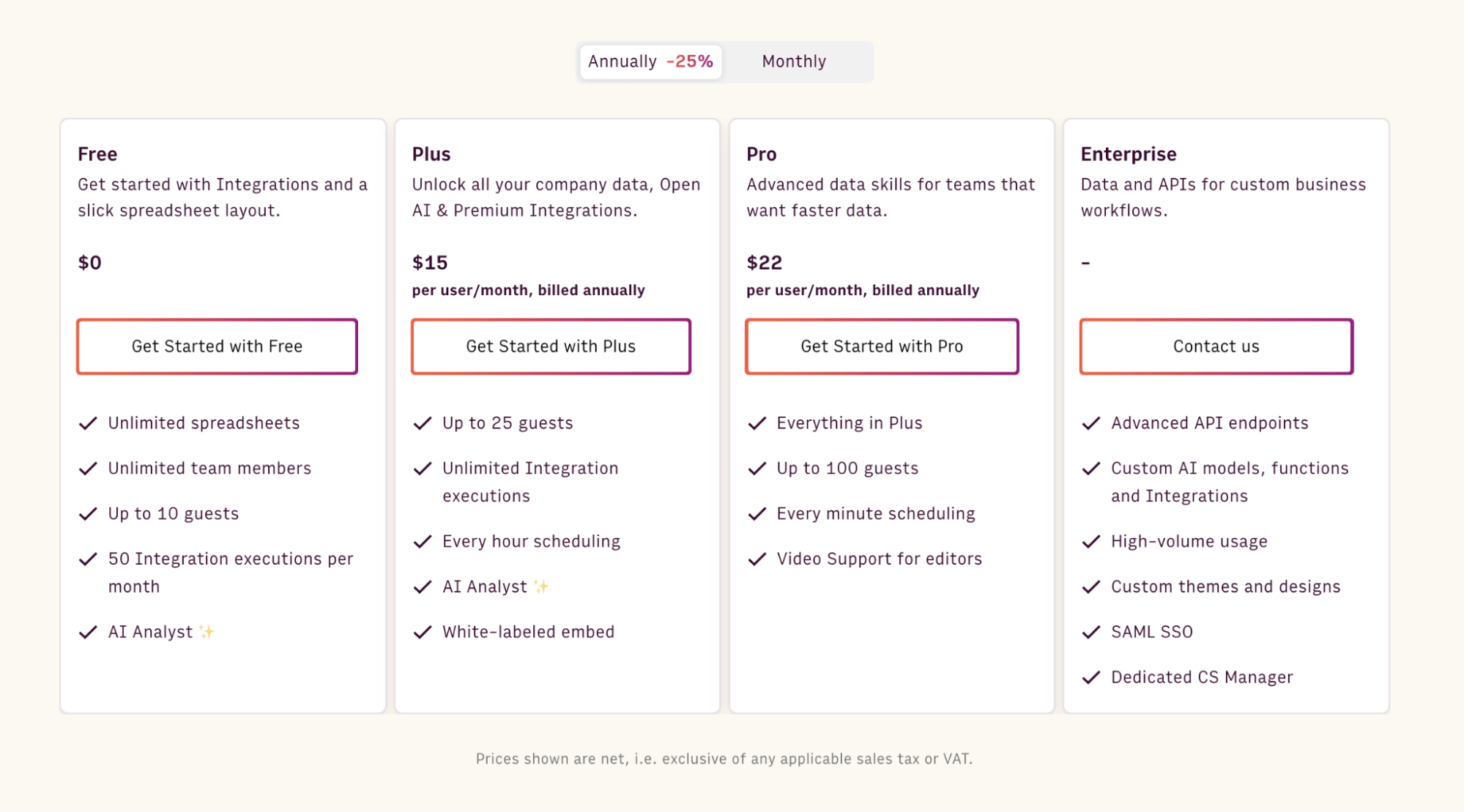
Airtable Pricing
Airtable offers a generous free version, limited to 1,000 records. It can prove costly if you've got an ever-expanding database needing more rows and columns. Airtable is still a great choice for visualizing various data types.
Airtable has three paid plans:
Team: $24 per seat per month
Business: $54 per seat per month
Enterprise: Custom pricing
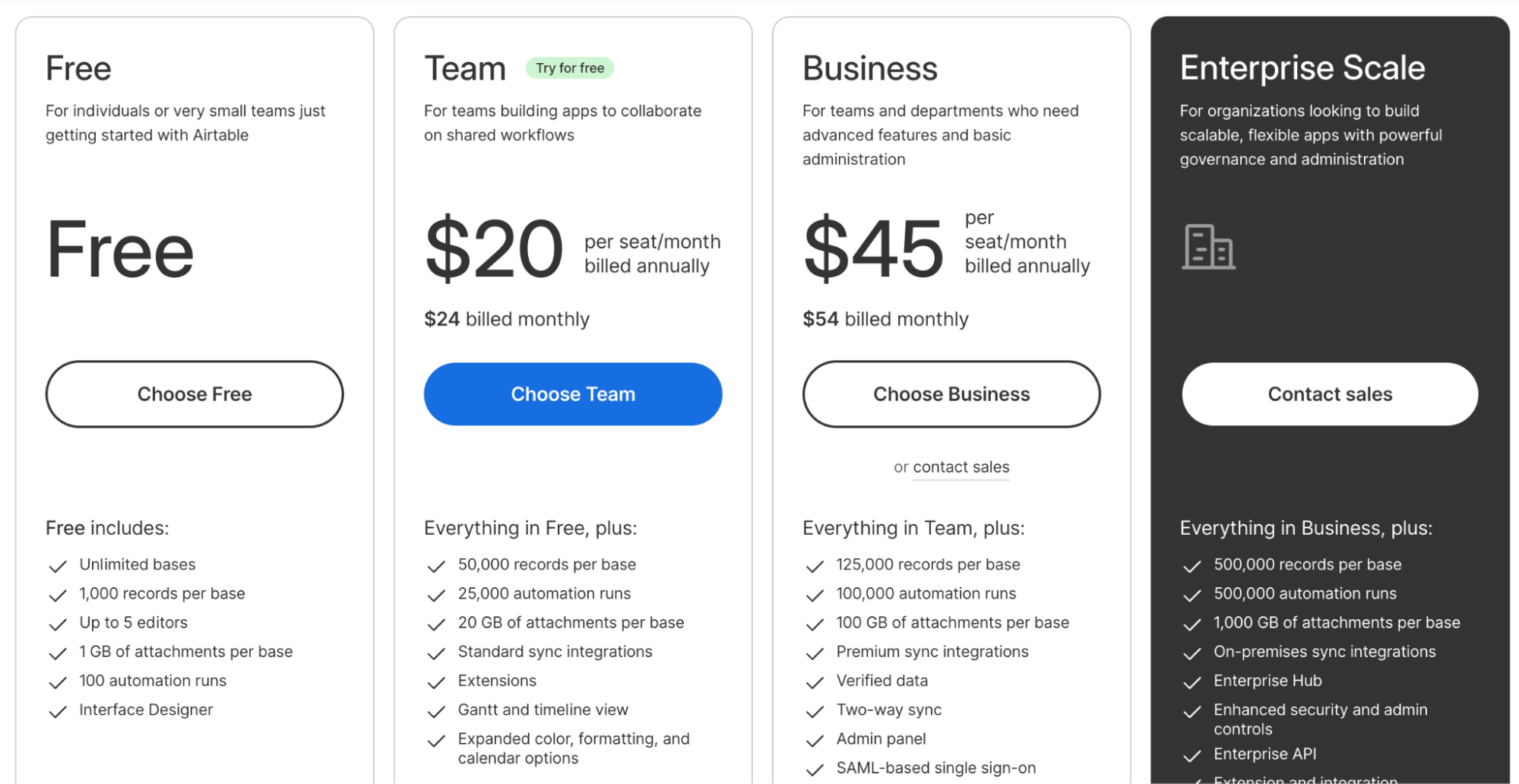
Google Sheets Pricing
Google Sheets is free for individual use. However, for businesses, Google Sheets is available as part of Google Workspace.
Here are its four annual plans billed annually:
Business Starter: $6 per user per month
Business Standard: $12 per user per month
Business Plus: $18 per user per month
Enterprise: Custom pricing

What are Customers Saying?
Rows Reviews
Rows makes it easy to collaborate with your team members on multiple spreadsheets.
“Connected spreadsheets are a crowded space with Airtable and other contenders dominating the space. Rows has taken a simple, collaborative approach that allows you to pipe in data from multiple sources and work with it efficiently. I highly recommend exploring it for your team or your next solo project.”

Users are happy with the variety of features Rows offers and its AI capabilities.
“I've been using Rows for several years now and I can honestly say it's the best way to work with spreadsheets. 📊 So I'm excited to see the new 2.0 version launch on PH today! 🔥There are so many new features to explore, from the API to the chart embeds, and the GPT-3 integration is just mind-blowing.” - Product Hunt.
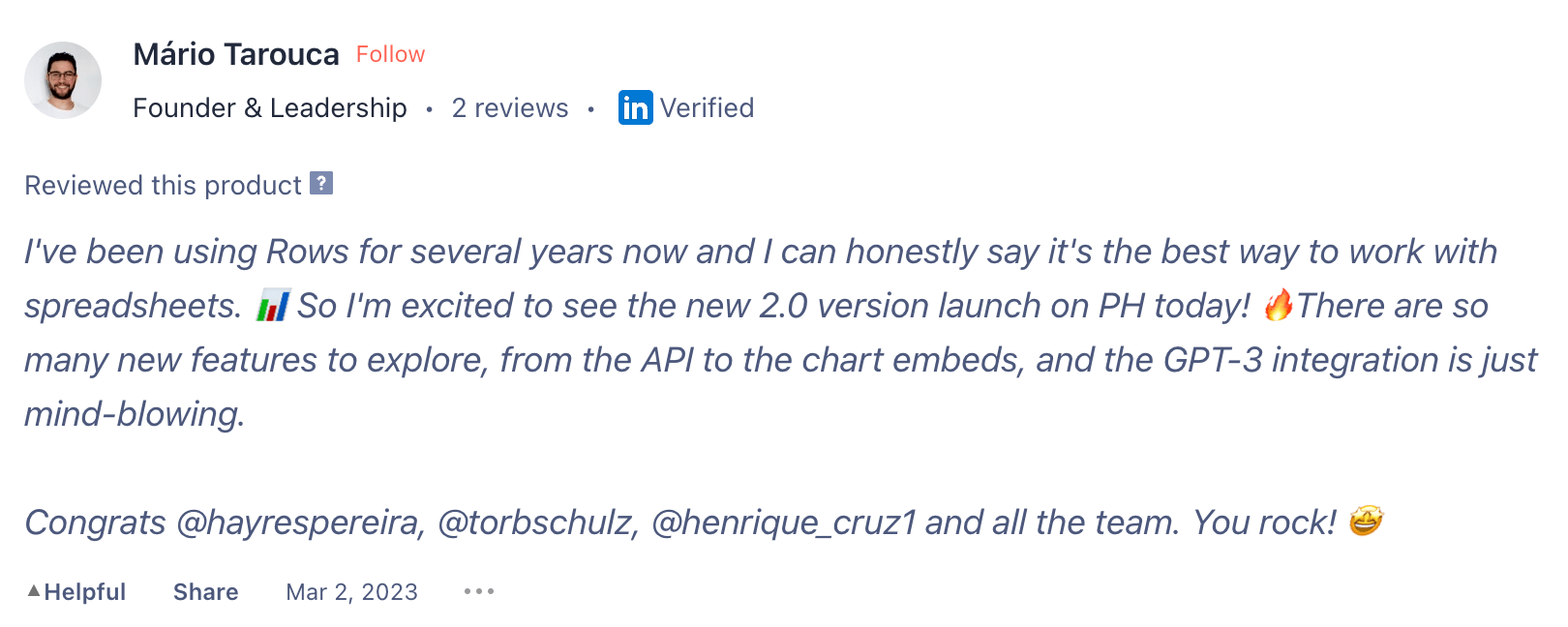
The knowledge base Rows offers for every feature and integration is commendable, and users love it.
“Excellent job, before beginning to use the Rows, I really love short introduction videos as a taste of getting started tutorial. And also asking the user's level of understanding about spreadsheets was a plus. It is easy to use and easy to share. Good visual design!” - Product Hunt.


Your new AI Data Analyst
Extract from PDFs, import your business data, and analyze it using plain language.
Try Rows (no signup)Airtable Reviews
According to an Airtable user, the tool excels at managing multiple data types. Its highly visual interface ensures smooth collaboration among teams.
The user, however, highlighted Airtable's lack of data analysis functions. Other than filtering and grouping, there's not much in there to drill down on data.

Another Airtable user praised its dynamic viewing styles and well-numbered integrations. The reviewer also cited a learning curve for new users.

Airtable lacks the traditional spreadsheet interface. Additionally, it has many features and buttons, giving it a steep learning curve for new users.
Google Sheets Reviews
Unlike Airtable, Google Sheets users find the spreadsheet app simple and easy to use. A user mentions that the learning curve is minimal due to its familiar interface. Plus, the vast documentation from Google makes it even easier for anyone to use the spreadsheet app to the fullest.

However, the previous reviewer was from a small agency owner (1-10 employees). So, I researched for reviews from a larger enterprise. Guess what?
We found a large enterprise Google Sheets user was happy with Google Sheets collaboration and offline mode features but complained about clunky processing time and lack of powerful functions when compared to Excel.

Wrapping Up
This detailed comparison will help you decide which spreadsheet software is best for your business.
Here’s a quick recap:
Rows’ AI capabilities, integrations, and unique features makes it one of the best spreadsheet software in the market. It can help you:
Make data analysis easier by leveraging AI, even for non-data-friendly users.
Build charts, graphs, and more elements that help you with data visualization.
Integrate with data warehouses, finance, marketing, and many more apps to import and export data.
Airtable is the best match for you if your priority is building customizable apps and automations over data analysis and visualization.
Google Sheets is a great free spreadsheet software for individuals looking to analyze mid or large-sized datasets and need a large number of functions and formulas.
If you or your team don’t have the time to try all three spreadsheet tools, go to Rows.com, import data, automate your report, and see if it's the right match!
Related Reading

